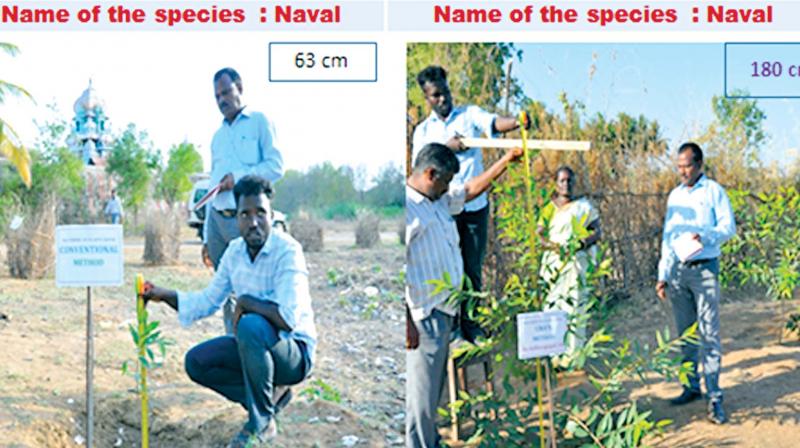Novel way to grow saplings faster while conserving water

Chennai: This is good news to drought-hit farmers and those who plant saplings under afforestation projects. The state government is all set to campaign about water conserving root-zone irrigation (CRI) technique developed by a serving IAS officer. The technique has proved to be successful in Madurai, Thanjavur, Tiruvarur and Krishnagiri districts under 2016 MNREGA schemes.
“Every year thousands of saplings are planted and their survival depends on various factors, particularly on frequent watering during the first three years of plantation. The current method adopted for watering is low cost and effective.
This ensures a faster and healthier tree growth in tested species like mango, teak, redwood and poongan,” said K. Satyagopal, principal secretary and commissioner of revenue administration and state disaster management.
Recognising the significance of afforestation in combating the issues of global warming, soil erosion and pollution this technique was developed. For instance a Naval sapling planted under the conventional method grew up to 63 centimetre and using the CRI technique the sapling grew up to 180 centimetres.
Other species including mango showed similar results where saplings grew taller and healthier ranging from 1 to 4 feet of enhanced growth through CRI within a year. The officer, who has won the appreciation of the State as part of the Independence Day celebrations, has decided to expand the technique in other areas through rural development department, which tested the technique last year.
“The cost of watering and maintenance for a longer period is an issue and, if the saplings grow faster, their survival chances are better. This is something like giving an additional supplement to make the saplings grow fast and there is no money required to implement this technique,” said conservationist K. Brinda of Biodiversity Conservation Foundation.
How you can follow this technique at your garden
To begin with a pit of 2 feet is dug as done in conventional methods and additional holes are drilled further up to
1-foot depth in the corners of the pit using a crowbar depending on soil type. Four PVC pipes of 3-foot length and 3 to 4 inch diameter are placed vertically in the corners of the pit to create water-absorbing columns filled with river sand and compost. Sieved vermicompost or manure is mixed with river sand or red soil and applied in the bottom of the pit to a height of half a foot. Then the pit is filled with removed soil mixed with vermicompost or manure. The sapling is now planted in the pit after adding some more quantity of un-sieved vermicompost or manure and the pit is filled fully. PVC pipes are removed creating four sand columns that absorb water faster and is stuffed with soil nutrients which are two feet below the surface i.e. to the root zone. Once the sand column is saturated, the moisture spreads laterally and the entire root zone sphere will retain moisture enabling faster growth. The innovative low cost watering technique was implemented by Rural Development and Panchayat Raj Department during 2016.

